How a cesspool is constructed without a bottom: schemes and arrangement rules
The very first point of an autonomous sewage system on a site is often a cesspool without a bottom. Make it not difficult. Since the design of such a sewer structure is extremely simple, it does not require special building skills and materials not commercially available.
Nevertheless, negligence in the construction of such a useful facility can turn into a big disaster. In the article we presented, the rules for the construction of a treatment facility for an independent sewer system are described in detail. The nuances of its operation and maintenance are given.
The content of the article:
The principle of operation of the pit without a bottom
A cesspool is a storage of gray waste from human activity, i.e. drains generated during household activities, cooking and hygiene.
It is arranged at a certain (defined by sanitary standards) distance from the house. To install such a sewage system, you need to dig a hole, strengthen and protect its walls from moisture, install an upper ceiling, and also bring a sewer pipe to the tank.
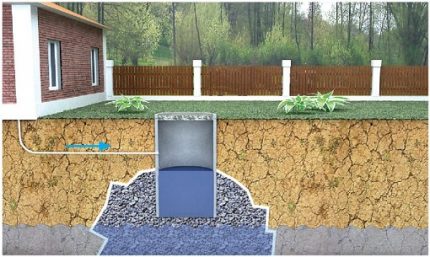
Waste water enters the tank, and the overlap reliably protects others from unpleasant odors. The settled liquid component of the waste mass seeps into the underlying soil layers, and solid inclusions settle on the surface of the sand and gravel filter.
Over time, the tank fills with insoluble solid sediment, and its contents must be removed. To do this, use a special sewer machine, although a small pit in volume can also be cleaned with a conventional bucket.
The drains inside the pit vary slightly in composition over time. Partially they are processed by microorganisms, solid fractions turn into sediment, and the liquid part is separated.In order to reduce the number of drains in order to use the services of wastewater as little as possible, a hole is made “without bottom”.
The walls of the tank for gray drains are carefully closed up, and at the bottom leave a gap with soil. On top of the soil, a filter is made of natural materials: sand, gravel and gravel. The liquid part of the effluent slowly seeps into the soil, and the solid fractions remain inside the sewer tank.
Wastewater passing through the filter receives additional treatment. Finally, liquid waste is processed in the thickness of the soil with the help of microorganisms that live there.
In order to speed up and strengthen the processing process, they add to the pit biological agentsbased on the action of natural bacteria. Similar preparations are also used inside accumulative sealed cesspools to perform biological wastewater treatment and reduce sediment volume.
The "bottomless" sewer design is very convenient. It allows you to remove the liquid part of the effluent in a natural and safe way. As a result, the capacity is filling up more slowly, and it is not necessary to pay for the services of cesspool workers so often.
An interesting variation of the pit without a bottom is a post-treatment system in the form of a filter well. It is installed after the septic tank, in which the primary processing of effluents is carried out.
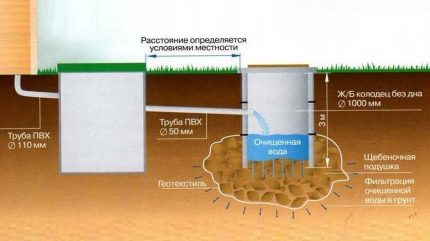
Both sections are connected by an overflow pipe. First, the effluents enter the hermetic sewerage department.
Here, the waste settles, solid fractions settle to the bottom, light technical pollution accumulate at the top, and the so-called “gray drains”, i.e. purified water from the listed contaminants, reach the overflow level and move to the tank without a bottom. Wastewater is filtered and disposed of into the ground, as previously described.
The use of special microorganisms makes the design almost a complete septic tank, which operates on the basis of similar principles.
It makes sense to make such a two- or even three-chamber construction only for a house in which a significant number of people live, in connection with which it is planned to receive a large amount of drains. And for the summer cottage, you can arrange a relatively small cesspool.
Calculations and technical standards
To cesspool functioned correctly, you need to correctly select a place and calculate the volume of capacity. To begin with, it should be remembered that, according to sanitary standards, such a structure cannot be used in areas where groundwater runs high. The bottom of the tank must be at least 1 m above this level.
An approximate calculation of the pit volumes can be performed on the basis of the average standard: 0.5 cubic meters. m for every person who lives in the house permanently. Depot Depth usually varies between two to three meters. This is dictated by the peculiarities of the operation of the suction pumps, which do not service structures deeper than three meters.
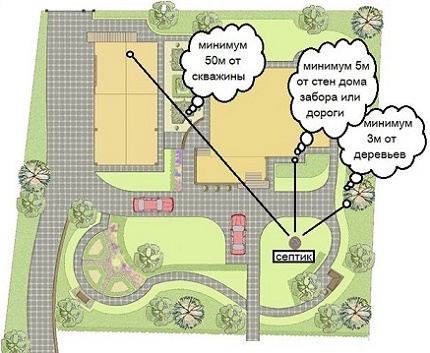
It is also necessary to take into account the following point: the pit is cleaned when the tank is filled to two-thirds of the total volume, and not to the very top. The dimensions of these two-thirds are best made in multiples of the dimensions of the capacity of the sludge pump.
This is beneficial, since the cesspool workers do not pay for the number of drained effluents, but for each specific exit, i.e. you even have to pay for the export of a small amount of effluent at full cost.
On different soils, there are different standards for the placement of a cesspool. It is usually recommended to place this structure at least five meters from the apartment building and at least 25-50 meters from the source of drinking water.
Standards are dictated by the risk of contamination of the soil or source by runoff. This can happen during the spring flood, improper installation of the sewage system can also cause such troubles.
The greater the filtration properties of the soil, the faster the wastewater penetrates inside, and the more stringent standards should be followed when designing a cesspool.
The best option is to install a structure with a deepening of the conditional bottom in sandy soil. Filtration of effluents into clay soils is not possible, therefore, in areas with loamy or sandy loamy bases, pits without a bottom are not installed.
When a structure is installed on dusty or clay sand, similar in properties to sandy loam, the rate of penetration of effluents into the ground is increased by using perforated rings. The result is a variation of a cesspool without a bottom with permeable walls.
And one moment. If special equipment is used to clean the cesspool, convenient access roads must be provided. The maximum permissible distance between the suction pump and the object is no more than four meters, but the shorter the distance, the more convenient it will work for the sewage system.
What can a rake be made of?
As a material for the walls of such sewers, a variety of materials are used:
- brick;
- monolithic concrete;
- ready-made concrete slabs;
- concrete rings;
- wood;
- silicate block;
- plastic, etc.
Brickwork for a cesspool is quite suitable, but its installation will take a lot of time. It will come out expensive for the costs, but it makes sense to consider this option if the owner of the site has a sufficient amount of brick unclaimed for other needs.
Of course, you don’t need special beauty here, but you should not take very poor-quality bricks, nevertheless, the constant effect of drains on the walls of the pit has a serious destructive effect.
Some novice masons prefer to put their hand on just such an object, since all the flaws will still be hidden under a layer of waterproofing and a top floor. But excessive negligence can play a cruel joke with an inexperienced master: an uneven brick wall in fact often turns out to be extremely fragile.
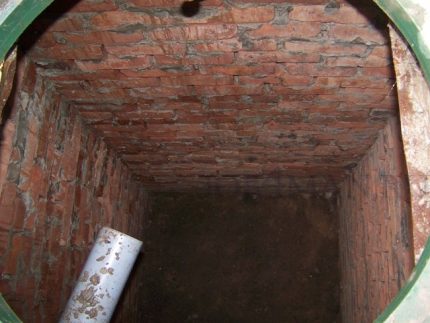
The gas silicate block is noticeably larger in size than the brick. With such material, work will go faster. Wood is not the best choice due to the same damaging effects of effluents.
The pit finished with boards will have to be repaired almost every year. Casting with concrete is traditionally carried out: with the help of formwork. At the bottom leave a gap for the sand and gravel filter. The design is necessarily reinforced.
Concrete rings are the most popular and convenient choice for cesspool facilities. But it should be remembered that poor-quality designs are unacceptable. Of course, a cesspool is not a well, but it also needs to be built correctly. Chips, cracks and other similar damage to the structure should not be.
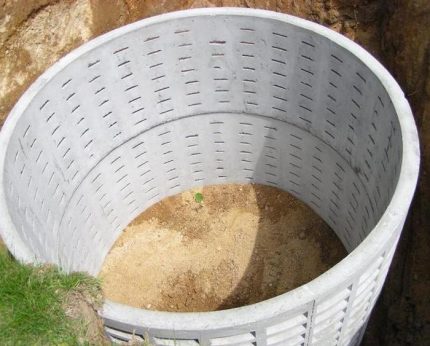
The downside of concrete structures is the impressive weight of the structure, which complicates installation and makes repair difficult. What you need to do if the concrete rings of the sewer point sagged, described here.
Plastic containers are widely used to create sealed cesspools, but if you make a hole for the filter, you can use the tank for sewage without a bottom. Plastic is a lightweight material.
Just in case, you can make it harder or harder plastic container. Especially if during the winter period it remains unfilled so that the structure is not displaced by frozen soil or floats during the flood.
Separately, it is worth mentioning another option - used tire cesspool. It is not difficult to build it: they dig a round hole, suitable in size, and put tires inside, one on top of the other.
Tires protect the walls of the pit from collapse and prevent the penetration of effluents into the ground. The tires should be interconnected, and the joints treated with sealant. At the bottom of the structure put a traditional sand and gravel filter.

It is customary to put a tire pit in sandy soils, in areas with low groundwater, where there is no threat of heavy spring floods. Otherwise, during the flood period, the environment may be infected by untreated waste mass during the depressurization of joints.
The advantages of such a structure are the low cost of time and the use of inexpensive materials. But it is worthwhile to understand that the service life of such a structure is small - only several years.
Installation of an object from concrete rings
Since concrete rings are the most common option for constructing a cesspool, it makes sense to consider it in detail.
Here is a general diagram of the installation work:
- Mark up.
- Dig a pit.
- Install rings.
- Bring a sewer pipe to the object.
- Make a hole for the pipe and insert it into the container.
- Seal all joints.
- Apply a layer of waterproofing material.
- Lay a sand and gravel filter at the bottom of the structure.
- Backfill the pit.
- Install upper ceiling with cover.
- Cover the floor with soil or decorate it.
Under a small pit, the pit can also be dug manually.It will take a bayonet shovel to dig, a bucket on a rope to take out the soil, a shovel to put it in a bucket, and a partner on top to pull this bucket. A concrete ring is put on the ground, and dug inside.
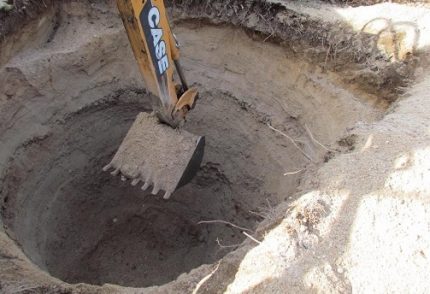
As a result, the ring is gradually lowered, preventing the collapse of the walls of the pit. For a large rake, it’s better to invest in renting an excavator. The speed of work will increase significantly. Here you can also first put a ring on the ground, and then begin work. You will need an excavator with the appropriate bucket size and an experienced operator.
The trench for the sewer pipe must have slight bias, 2 - 3 cm per linear meter. If the freezing of soil in the winter is characteristic of this area, then the pipe above this mark should be insulated.
The hole for the pipe is punched in a suitable place after it is laid. If you make such a hole in advance, you can not trite to guess the height of the pipe.
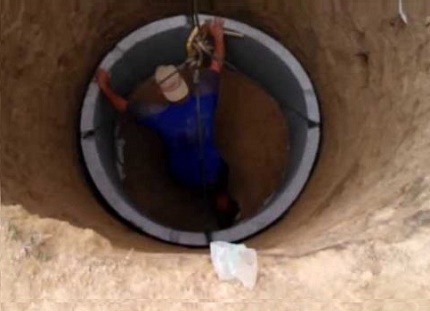
Joints of concrete rings, as well as the place of entry of the pipe, are treated with a solution. Then a layer of waterproofing material should be applied. An inexpensive coating is suitable.
This step is not considered mandatory if all joints are securely sealed. However waterproofing layer protects the structure from damage, and this will significantly increase the terms of its operation.
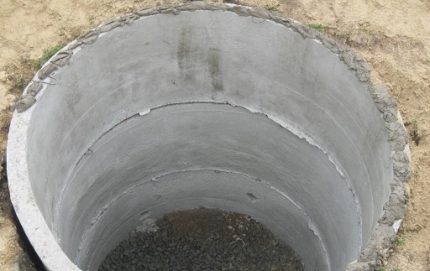
The bottom filter is formed from river sand and gravel. Crushed stone of suitable fractions can also be used. First, sand is covered with a layer of about 30 - 35 cm, then two layers of gravel or gravel of approximately the same thickness.
Small particles should be at the bottom, and large ones at the top. Now you need to set the top overlap. Usually, a ready-made concrete slab of the appropriate size and configuration is taken for this.
There should be a hole in the ceiling that is large enough so that you can not only lower the suction hose, but also send a person to inspect the condition of the tank after cleaning it. This hole is closed with a lid so that odors do not disturb others.

Some owners prefer to make a double cover. It reliably protects from odors and from freezing of effluents in the winter. A layer of soil is usually applied on top of the ceiling so as not to spoil the landscape.
The lid, of course, must be left free, it should be 20-30 cm above the ground level. Now you only need to monitor the level of effluents in the tank and remove them in a timely manner.
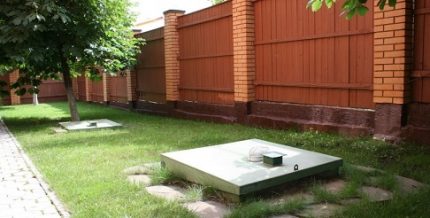
If everything is calculated correctly, then cleaning will only be needed a couple of times a year. After the cesspool is cleaned, does not put a man down in overalls. Its task is to inspect the walls of the structure, check their integrity.
Periodically flush the bottom filter or replace it completely. All work inside the cesspool must be done only in the presence of a partner, who is at the top for insurance.
Construction of a cesspool with overflow
A pit with an overflow is a sewer object that is more complicated in the technical and constructive sense. Her device will require more effort and investment, but it will be possible to turn to the dumpers much less often.
In overflow sewage treatment plants, two or three chambers are arranged, the first of which are equipped with a sealed bottom. The finish chamber is always constructed by type filter wells.
The following selection of photos will introduce the main stages of the construction of such a treatment plant:
Biological products for cesspools
The presence of special bacteria in the tank can significantly increase the efficiency of the sewage system, as well as reduce the speed of its filling. Usually these are specially selected complexes of anaerobic (i.e., able to exist without oxygen) microorganisms. These bacteria are able to process effluents, decomposing them into more or less clean water and neutral sludge.
Such biological wastewater treatment significantly reduces the risk of soil contamination. If the degree of purification is high enough, water can even be used for irrigation, and the formed sludge can be used as fertilizer.
In practice, after biological processing, the amount of liquid in the effluent increases, it is utilized faster into the soil, and sludge accumulates more slowly than when using a cesspool without bacteria.
Such preparations are sold in the form of concentrated liquids, granules, powders, tablets, etc. The package contains detailed instructions, which you must follow. Powder and granular preparations usually need to be previously diluted in a small amount of water, and the concentrates are immediately sent to the sewer.
In this case, you should pay attention to the list of chemicals that have a detrimental effect on these microorganisms. Such substances, such as chlorine, are found in various household chemicals. Particular attention to what gets into the sewer should be given to owners of automatic washing machines.
If all the instructions are followed precisely, then you will not have to replenish the colony of bacteria in the cesspool. They multiply and maintain the required number. If the unpleasant smell from the cesspool has become stronger or has changed in the direction of deterioration, this may indicate that a significant part of the microorganisms has died, the colony needs to be restored.
In detail, methods for cleaning cesspools are disassembled. in the next article, which we advise you to familiarize yourself with.
Conclusions and useful video on the topic
The process of creating a cesspool is clearly presented in this video:
Here is the procedure for filling the walls of the cesspool with monolithic concrete:
This video tells how to clean a cesspool using a pump yourself:
A cesspool of this type is a convenient and useful structure. It can be used to dispose of waste safely and efficiently. At the same time, it is important to strictly comply with the technology and adhere to established sanitary standards.
Please write comments in the block below. Tell us about how you built a cesspool with a filter bottom in your country house or suburban area. Ask questions, share opinions and useful information, post a photo on the topic of the article.

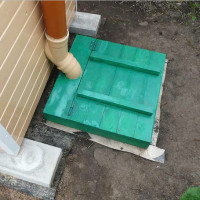 How a cesspool is constructed in a private house: a review of structures + rules for their arrangement
How a cesspool is constructed in a private house: a review of structures + rules for their arrangement 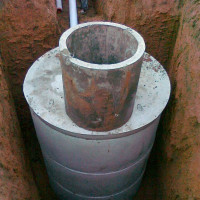 How to construct a cesspool of concrete rings: schemes + step-by-step guide
How to construct a cesspool of concrete rings: schemes + step-by-step guide 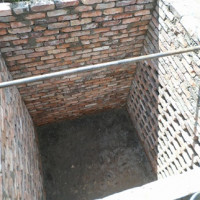 How to build a drain pit of brick: options and methods of arrangement
How to build a drain pit of brick: options and methods of arrangement 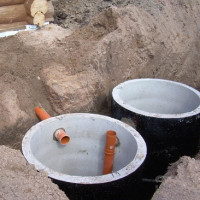 How a cesspool with overflow is arranged: schemes and construction technology
How a cesspool with overflow is arranged: schemes and construction technology 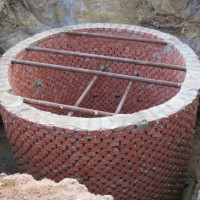 Do-it-yourself cesspool: analysis of popular options for arranging
Do-it-yourself cesspool: analysis of popular options for arranging 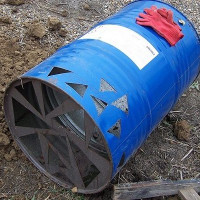 Barrel pit: step-by-step master-class on arrangement
Barrel pit: step-by-step master-class on arrangement  How much does it cost to connect gas to a private house: the price of organizing gas supply
How much does it cost to connect gas to a private house: the price of organizing gas supply  The best washing machines with dryer: model rating and customer tips
The best washing machines with dryer: model rating and customer tips  What is the color temperature of light and the nuances of choosing the temperature of the lamps to suit your needs
What is the color temperature of light and the nuances of choosing the temperature of the lamps to suit your needs  Replacement of a geyser in an apartment: replacement paperwork + basic norms and requirements
Replacement of a geyser in an apartment: replacement paperwork + basic norms and requirements
Our cesspool of two rings for 2 cubes worked fine for about 5-6 years. Then quiet horror began, because our everyday life depended on the fullness of the pit! It was filled in 10-12 days, and we can not cause pumping more than once a month! They undertook to bring the drain from the washing machine and kitchen tap into the courtyard of the “watering path” in order to somehow reduce the load on the sewer object! Bacteria did not help much, they mostly work in the summer. What to do - I can’t imagine! Really dig a new cesspool ???
Do not worry, almost certainly the functionality of your cesspool can be restored. Apparently, the soil has lost its filtering ability and cannot absorb liquid. There may be several reasons why this happened.
The most common is the formation of a greasy film on the bottom and walls of the pit due to the large amount of fats and soaps discharged into the pit. You can fix this by using special tools (Roetech K-87, Dr. Robik 809, or similar), after pumping dirty liquid out of the pit.
Another reason may be siltation of the bottom. It is solved by mechanical cleaning, or by the use of biological preparations against siltation.
Making a cesspool without a bottom is easy. It will turn out not so expensive if you use either a used brick or plastic. But, thinking over my own, I remembered the pit that this building was not for one year, so I walled up 2 reinforced concrete rings. The joints were sealed with a solution. I laid the lid on top.He led a PVC pipe from the house to the pit and now we use sewers without troubles.